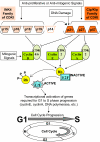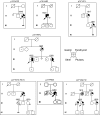Rare germline mutations in cyclin-dependent kinase inhibitor genes in multiple endocrine neoplasia type 1 and related states
- PMID: 19141585
- PMCID: PMC2684477
- DOI: 10.1210/jc.2008-2083
Rare germline mutations in cyclin-dependent kinase inhibitor genes in multiple endocrine neoplasia type 1 and related states
Erratum in
- J Clin Endocrinol Metab. 2009 Jul;94(7):2674
Abstract
Context: Germline mutation in the MEN1 gene is the usual cause of multiple endocrine neoplasia type 1 (MEN1). However, the prevalence of identifiable germline MEN1 mutations in familial MEN1 cases is only 70%. Some cases may have a germline mutation in another gene such as the p27 cyclin-dependent kinase inhibitor (CDKI).
Objective: The aim of the study was to investigate cases of MEN1 or related states for germline mutations in all CDKI genes.
Methods: A total of 196 consecutive index cases were selected with clear or suspected MEN1 and no identifiable germline MEN1 mutation. Every case was analyzed for germline mutation in each of the seven CDKI genes.
Results: We identified benign polymorphisms of the CDKI genes and also 15 other initially unclassified sequence variants. After detailed gene/protein analysis, seven of these 15 variants were classified as probably pathological mutations. Three of these seven were probable mutations of p27. The remaining four were probable pathological mutations in three of the other CDKI genes, thereby implicating these three genes in the germline of human tumors. The identification rates for probably pathological mutations among the 196 index cases were similarly low for each of four CDKI genes: p15 (1%), p18 (0.5%), p21 (0.5%), and p27 (1.5%). No characteristic clinical subtype related to MEN1 was identified among the seven index cases and their families.
Conclusion: Rare germline mutation in any among four (p15, p18, p21, and p27) of the seven CDKIs is a probable cause of MEN1 or of some related states.
Figures




Comment in
-
Multiple endocrine neoplasia type I variants and phenocopies: more than a nosological issue?J Clin Endocrinol Metab. 2009 May;94(5):1518-20. doi: 10.1210/jc.2009-0494. J Clin Endocrinol Metab. 2009. PMID: 19420274 No abstract available.
References
-
- Brandi ML, Gagel RF, Angeli A, Bilezikian JP, Beck-Peccoz P, Bordi C, Conte-Devolx B, Falchetti A, Gheri RG, Libroia A, Lips CJ, Lombardi G, Mannelli M, Pacini F, Ponder BA, Raue F, Skogseid B, Tamburrano G, Thakker RV, Thompson NW, Tomassetti P, Tonelli F, Wells Jr SA, Marx SJ 2001 Guidelines for diagnosis and therapy of MEN type 1 and type 2. J Clin Endocrinol Metab 86:5658–5671 - PubMed
-
- Ozawa A, Agarwal SK, Mateo CM, Burns AL, Rice TS, Kennedy PA, Quigley CM, Simonds WF, Weinstein LS, Chandrasekharappa SC, Collins FS, Spiegel AM, Marx SJ 2007 The parathyroid/pituitary variant of multiple endocrine neoplasia type 1 usually has causes other than p27Kip1 mutations. J Clin Endocrinol Metab 92:1948–1951 - PubMed
-
- Marx SJ 2002 Multiple endocrine neoplasia type 1. In: Vogelstein B, Kinzler KW, eds. The genetic basis of human cancer. 2nd ed. New York: McGraw Hill; 450–475
-
- Vierimaa O, Georgitsi M, Lehtonen R, Vahteristo P, Kokko A, Raitila A, Tuppurainen K, Ebeling TM, Salmela PI, Paschke R, Gündogdu S, De Menis E, Mäkinen MJ, Launonen V, Karhu A, Aaltonen LA 2006 Pituitary adenoma predisposition caused by germline mutations in the AIP gene. Science 312:1228–1230 - PubMed
-
- Simonds WF, James-Newton LA, Agarwal SK, Yang B, Skarulis MC, Hendy GN, Marx SJ 2002 Familial isolated hyperparathyroidism: clinical and genetic characteristics of 36 kindreds. Medicine (Baltimore) 81:1–26 - PubMed
Publication types
MeSH terms
Substances
Grants and funding
LinkOut - more resources
Full Text Sources
Other Literature Sources

